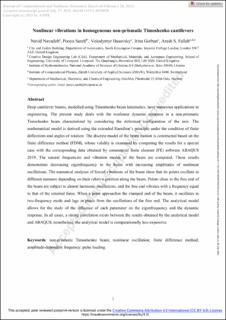| dc.contributor.author | Navadeh, Navid | |
| dc.contributor.author | Sareh, Pooya | |
| dc.contributor.author | Gorban, Irina | |
| dc.contributor.author | Basovsky, Vladimir | |
| dc.contributor.author | Soleiman Fallah, Arash | |
| dc.date.accessioned | 2021-10-15T17:15:08Z | |
| dc.date.available | 2021-10-15T17:15:08Z | |
| dc.date.created | 2021-07-27T18:57:40Z | |
| dc.date.issued | 2021-08-11 | |
| dc.identifier.issn | 1555-1415 | |
| dc.identifier.issn | 1555-1423 | |
| dc.identifier.uri | https://hdl.handle.net/11250/2823418 | |
| dc.description.abstract | Deep cantilever beams, modelled using Timoshenko beam kinematics, have numerous applications in engineering. The present study deals with the nonlinear dynamic response in a non-prismatic Timoshenko beam characterized by considering the deformed configuration of the axis. The mathematical model is derived using the extended Hamilton’s principle under the condition of finite deflections and angles of rotation. The discrete model of the beam motion is constructed based on the finite difference method (FDM), whose validity is examined by comparing the results for a special case with the corresponding data obtained by commercial finite element (FE) software ABAQUS 2019. The natural frequencies and vibration modes of the beam are computed. These results demonstrate decreasing eigenfrequency in the beam with increasing amplitudes of nonlinear oscillations. The numerical analyses of forced vibrations of the beam show that its points oscillate in different manners depending on their relative position along the beam. Points close to the free end of the beam are subject to almost harmonic oscillations, and the free end vibrates with a frequency equal to that of the external force. When a point approaches the clamped end of the beam, it oscillates in two-frequency mode and lags in phase from the oscillations of the free end. The analytical model allows for the study of the influence of each parameter on the eigenfrequency and the dynamic response. In all cases, a strong correlation exists between the results obtained by the analytical model and ABAQUS, nonetheless, the analytical model is computationally less expensive. | en_US |
| dc.language.iso | eng | en_US |
| dc.publisher | American Society of Mechanical Engineers | en_US |
| dc.relation.ispartofseries | Journal of Computational and Nonlinear Dynamics;Volume 16, Issue 10 | |
| dc.rights | Navngivelse 4.0 Internasjonal | * |
| dc.rights.uri | http://creativecommons.org/licenses/by/4.0/deed.no | * |
| dc.subject | Non-prismatic Timoshenko beams | en_US |
| dc.subject | Nonlinear oscillation | en_US |
| dc.subject | Finite difference methods | en_US |
| dc.subject | Amplitude-dependent frequency | en_US |
| dc.subject | Pulse loading | en_US |
| dc.title | Nonlinear vibrations in homogeneous non-prismatic Timoshenko cantilevers | en_US |
| dc.type | Peer reviewed | en_US |
| dc.type | Journal article | en_US |
| dc.description.version | acceptedVersion | en_US |
| dc.rights.holder | Copyright (c) 2021 by ASME | en_US |
| cristin.ispublished | true | |
| cristin.fulltext | postprint | |
| cristin.qualitycode | 1 | |
| dc.identifier.doi | https://doi.org/10.1115/1.4051820 | |
| dc.identifier.cristin | 1922828 | |
| dc.source.journal | Journal of Computational and Nonlinear Dynamics | en_US |
| dc.source.volume | 16 | en_US |
| dc.source.issue | 10 | en_US |
| dc.source.pagenumber | 1-23 | en_US |

